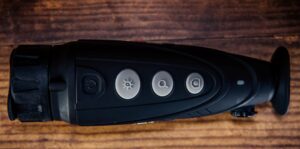What to Look for When Buying a Thermal Imaging Monocular – Advice by InfiRay and Thermal Devices.EU
As multipurpose tools, the perfect thermal monocular can bring a radical change for various applications. The biggest motivation behind the creation of the thermal imaging monoculars was to detect and search more freely, whereas people will have difficulties monitoring with regular devices. However, the real topic that will be addressed is: how to select the ideal thermal monocular? Before we get into it, let us begin with a basic overview of the thermal working concept.

Infrared thermal radiation is emitted by anything with a temperature greater than -273.15°C. The greater the radiation, the higher the temperature. The machine’s thermal detectors sense the radiation and convert it to electrical impulses. Through the use of sophisticated digital analysis, the signals are being converted to thermal imaging and shown on a high-quality LCOS or OLED display, which is how thermal imaging typically works.

To return to the original topic, the first consideration you should make while upgrading your equipment to temperature monocular, or if you are a newbie to thermal monocular, is your finances. Due to the high manufacturing costs, a high-quality thermal monocular is an item of high value. After we’ve established a budget, we should focus on the key characteristics that influence performance.
Heat sensors
Keep in mind, that the resolution of the thermal sensor has a direct impact on the sharpness of the thermal picture. The greater the sensor resolution under the same pixel pitch, the finer the quality of the thermal image. Today the most common sensor sizes are 12μm and 17μm; All other things the same, devices with 17m sensors typically produce better and sharper thermal imagery. The reduced detection scope of 17μm in comparison to 12The reduced detection scope of 17μm in comparison to 12m is flawed. By trends, the 12m thermal sensor has steadily gained the upper hand.

Thermal Lens
The passing of the light of a lens is determined by its material, which has an influence on thermal picture definition. Ge-lenses, which have a greater transmittance and reduced reflection to thermal radiation range from 8-14m, is used in InfiRay thermal monoculars. The detecting range scope is established by the focal length of the lens. The detecting distance increases as the focal length increases.

Sensor NETD (Sensitivity)
Detector efficiency is included with NETD. In reality, this parameter defines the thermal monocular’s sensitivity, which is defined as the least temperature distinction that the product is capable of detecting. If the sensor NETD is set let equal to or lower of 25mK, it indicates that the detector can measure the difference in temperature of 0.025°C. As a result, the thermal monocular becomes more sensitive as the NETD size decreases. With thermal sensor tech that is unrivaled in the business, InfiRay has introduced the E6 Pro thermal monocular along with E6+ V 3.0 and ZOOM ZH38 that feature detector NETD≤25mk, that include revolutionary characteristics that users can only benefit from.
Scope of detection
Specific detection range settings can be used to decide how far the thermal monocular can detect and search. For example, a detection scope of roughly 1280 meters for the E6 Plus thermal monocular means that a target the size of a regular person of 1.75m0.5m under ambient conditions can be identified at a distance of 1280 meters. It is necessary to know the difference between detection scope and visible scope. While the visual scope is more concerned with the identification, the detection scope is more concerned with locating the subject.

Types of batteries
In the industry, for thermal monoculars, you can choose from two types of batteries: either changeable battery packs or integrated built-in batteries. The built-in battery has acquired dominance on the market because of its structural integrity and longevity, while removable batteries provide mobility and continuous battery life. Between 4 and 5 hours of time usage is usually enough for most hunters.

Options for the menu
The thermal monocular can bring a groundbreaking change since it is powerful on the outside and also has multiple purposes. The user can resolve the situation with a variety of options, allowing him to enjoy freedom even in utter darkness. PIP (picture in image), color schemes, filming, and image capture are the most often utilized features on the thermal monocular.

To conclude, a nice thermal monocular will capture the user’s attention right away when they take their first bite. Thermal lens and focal length, high definition screen, and NETD are the major things to take into account for those that place picture quality at the forefront of their decision-making. Internal menu options such as installed memory, WI-FI color schemes, and battery are equally significant as the elements that define imaging sharpness are for customers who seek functionalities and utilizing experiences.




